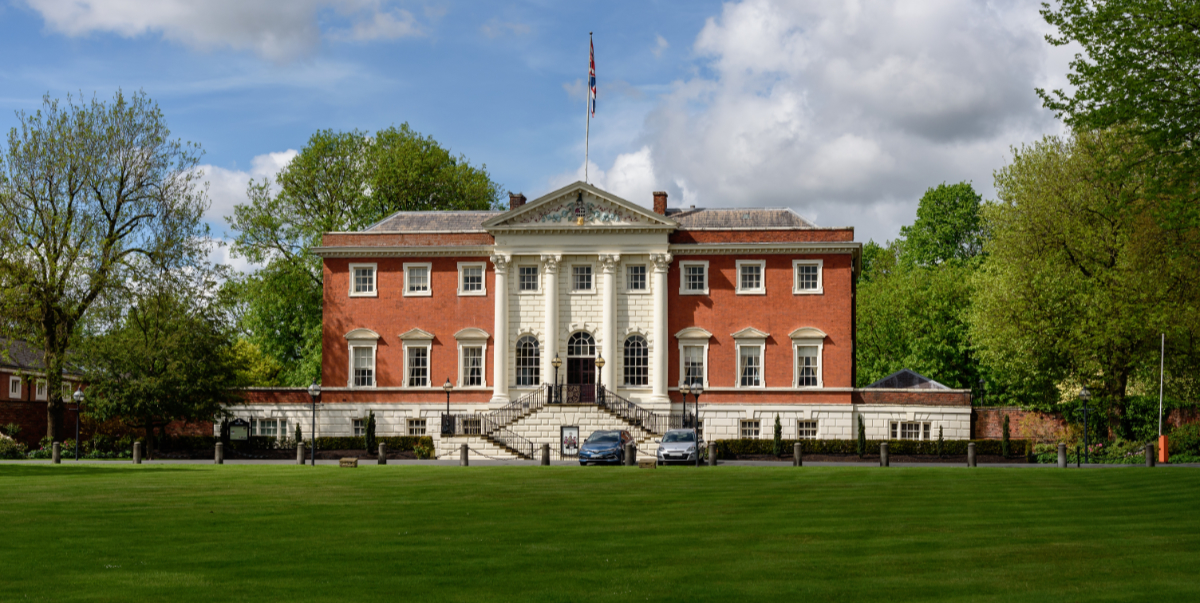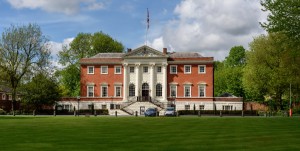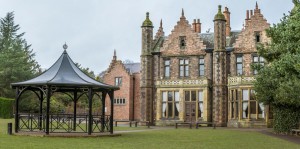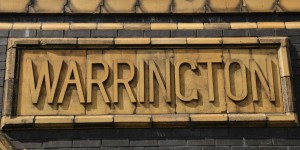
Warrington One of Cheshire’s Many Hidden Gems!
Want to get to know a place but don’t have much time? Do it with Five Minutes Spare!
In order to get to know more about this fine town, we paid it a visit and got to grips with the locals. Want to know where to party in Warrington, what to visit or where to spend your time? We did too, so we took a peek to try and find out more. Join us for a five-minute foray into Warrington and find out if it matches up to your expectations. It certainly exceeded ours.
Rumour has it that Warrington was founded by the Romans… so let’s start with them, in a little camp around a crossing place in the river…
Long Ago and Far Away…
Back in the days when England didn’t exist yet, the River Mersey was a formidable obstacle for anyone travelling between Manchester and Liverpool. There was a natural fjord where it was shallower, and thus Warrington was born. Archaeological evidence shows that this Fjord has been in use since the Bronze Age, where it was presumably used as a natural crossing point in the river.
There was no bridge at Warrington fjord until around 1285. Away back in the beginning of the town, however, this would have been the main reason to colonise the area. The Romans had a small settlement in Wilderspool in the same area as Warrington around 40 AD. When they left Britain around 100 AD, they would have left a small ghost town behind them.
The next mention of Warrington as a town was in 1070 AD, a short few years after the Norman invasion. King William had a castle built in Warrington – again, probably because of that fjord. It was only wooden though. A strange choice for a castle built beside a river with access to river stones. It suggests it was a hurried affair.
By the time of the Domesday Survey (the first ‘census’ of England’s lands) in 1086, Warrington is noted to have had only one ‘owner’ at the time, named Roger of Poitou. Roger owned one church – that was St Elphin’s Church. To this very day you can still attend a service there, although don’t worry – it isn’t the original building…
Poitou also owned two plough teams and the land made him 8 pounds a year. There were households of 8 men on the land, so that gives you an idea of how small it was. It is considered one of the smaller settlements of the time. Nevertheless, it was one of the hundred of Warrington. It would not have been named so if it wasn’t an important place.
A Little Later
Warrington wasn’t mentioned much throughout the next few years. It would have been a sleepy little village that marked a crossing point in the river. In the 12th century it was granted its first charter, turning it into an official market town and allowing them to hold an annual fair. By 1277 the fair became bi-annually, and the town would have flourished.
In the 13th century friars came to town… Augustinian Friars to be precise. They established a friary in Church Street near where the bridge was built. This would have been a direct attempt at claiming passing traffic for conversion. In 1495 it is thought that the monks had a hand in replacing the wooden bridge with a stone one. The friary was closed in 1539 by an angry Henry VIII when he declared war on the church.
The last mention we found of the friary was in the late 18th century, when a local gentleman wrote to the paper regarding a friend of his. This young lady had frequented her aunt’s home in Warrington when she was a young girl. One such summer she told him she had spied an old friar wandering the garden. Her aunt’s house, they say, was on the old friary grounds. So perhaps more of the friary survived than meets the eye.
Fun Warrington Facts!
Warrington doesn’t just have ghosts in every friary street, it has other interesting aspects that most people don’t know about. Here are some of our Five Minutes Spare favourite fun Warrington facts:
- The first Ikea store in Britain opened in Warrington. Did you know that when Swiss giants of the flat pack Ikea first crossed the pond to America, everyone bought the vases for drinking glasses? It seems things need to be bigger in America than they do in Europe…
- It’s one of very few governments designated New towns (of 1946) that has a history that stretches back to the Bronze Age. It may be designated a New Town and used for London overspill – but it is anything but new!
- Lewis Carroll was born in Warrington – the one who wrote Alice in Wonderland. It’s possible the park scene at the start was set with a Warrington park in mind[i]!
- Warrington have a yearly ‘walking day’, where every parishioner from every church goes out and walks through the streets in a parade. Over the years it has become a sort of fair in its own right.
- The city’s golden gates were actually made for Queen Victoria – who didn’t want them. She rejected the gates which were supposed to be placed on Sandringham Palace[ii]. Legend has it that she was thoroughly unamused to see them erected in Warrington – a town where Oliver Cromwell had such massive support, and where his statue still stands to this day…
OK, some of them were more interesting than fun – but don’t you feel more enlightened now? Let’s get back to the history and find out exactly why Cromwell had such a big influence here.
The Middle Ages Onwards
Not a good start. There were two outbreaks of the plague and a famine in the 17th century, and that’s before the English Civil War kicked off. It is believed to have remained a reasonably small settlement until around this time. Once the death and destruction were out of the way, the population was around 2,000. This paints a picture of a flourishing market town that was well on the way to recovery before the armies moved in.
Cromwell actually lived in Warrington while the war was going on. He billeted his army here, alongside the Earl of Derby. It was seized by Royalists early in 1642, but they only managed to hold it for a single year. The parliamentarians surrounded Warrington in the early months of 1643, preventing the town from thriving as its usual marketplace. With no goods entering or leaving town it wasn’t long before the Royalists gave up.
The town was disputed throughout the war. There was even a battle for the Bridge in 1651. When we mentioned ghost stories earlier, we weren’t kidding. Warrington has a lot of dead under its belt. Between plagues, dead friars, soldiers, and canon fire (it is rumoured some buildings on Church Street still retain the marks of canon fire), Warrington has had plenty of opportunities to accumulate morbid stories.
Warrington remained a sleepy town on the Mersey after the war. It recovered very gradually in population, but the markets sprang back. What really brought this town to life – as it is with all English towns – was the Industrial Revolution.
18th Century Warrington
When the Mersey finally became sailable in the 18th century, the town saw huge growth. Partially because of where Warrington is situated. It is in between Manchester and Liverpool, in a spot where a bridge crosses. Whoever first built a house here had the right idea. In the 17th century, it made a small fortune in the textiles industry selling cloth for sails to other cities. In 1770 most of the navy’s sails were stitched in Warrington.
When the Industrial Revolution hit Warrington took on a more decisive role in the textile industry. Their situation by the river allowed for mills to be built at the turn of the 17th/18th centuries. A very early form of hydroelectric power would have been used to turn the mill and make the fabrics. Tanning, brewing, and chemical mixing were all common here by the middle of the 19th century.
By then, steel was the biggest industry in Warrington by far. Canals were built to import and export it. It was processed and turned into hardware by skilled mongers. The glassware industry took off here, and sugar and copper were refined in its buildings. In 1801 the population was thought to be a little above 10k. in 1861 it was 26k… but by 1901 the population had tripled to 65k.
The Age Of The Train
1837 brought the benefits of the railway, 1821 saw gas streetlights. In 1828 they added a fire brigade, presumably scared after the great fires had reduced other cities to rubble. It took another ten years for Warrington to have a police force, so it must have been orderly. A cholera epidemic in 1832 led to nearly 200 deaths. Later, piped water and a sewer system was added. In 1810 a dispensary to provide medicine for the peasantry had opened. It took a further 60 years for them to get a hospital.
The earliest known park in Warrington was Bank Park, which was opened in 1873 and which you can still visit, to this day. It wasn’t enough that the Victorians opened a handful of public places, however. Warrington changed from a quaint middle-ages market town into an industrial beast. Driven by steel and textiles, the town was dirty, overcrowded, and contained more than a few poverties stricken areas.
The town responded in the early 20th century with council housing. More would have been provided if it hadn’t been for the interruption of two world wars… but more on that in a minute. We wanted to give a brief glimpse at famous folk to have come from Warrington, to ease the tension a little, first.
Famous People that Come from Warrington
There have been a few famous people that come from Warrington. We put some of them here so that you could see what a talented bunch they all are!
- Chris Evans – surely everyone knows the former presenter of TFI Friday and Don’t forget your toothbrush? No? Married to Billie Piper for a while? Remember? No? The ginger guy? We knew you would remember that part…
- Sue Johnston, who was in Brookside for years, is a famous Warrington face.
- Tom Smith, the pro footballer for Huddersfield town, is from Warrington.
- Pete Postlethwaite – one and only actor, is from Warrington.
- Kerry Katona, a 90’s singer of notoriety and more recently on First Dates, is a Warrington native.
Warrington is full of famous folk[iii]. There’s a bunch more but we have other things we need to cover. What happened in Warrington during the War, for example? Let’s get back to business…
Wartime Warrington
Warrington has been unfortunate enough to be bombed out with wartime, but we will get to that in a moment. During WWI and WWII few to no bombings were recorded in town. It was home to an important RAF airbase that was left alone. There are some stories (they make good reading) about the air raid sirens going off and bombs being dropped in fields. It doesn’t seem that Warrington was blitzed though so they got off lightly…
…Until 1993, when the IRA detonated two bombs aimed at harming civilians in Warrington town. Sometime after the war, the council built new housing and moved some of the overspill here. In the 60’s it was a designated New Town and the population expanded once again. Perhaps because it was so populous, this is where the IRA chose to strike.
The group had attacked a gas storage plant in the area a few weeks beforehand but returned to plant two bombs in the town centre. Two children, a 3-year-old and a 12-year-old died at the scene. Nearly 60 other people were injured. The IRA has done some terrible things in their time that are best not forgotten.
Anyway. Nowadays Warrington sits in a Green Belt area, surrounded by the beauty of the countryside and protected against any more slums. Let’s hope it continues to remain so for the years to come.
Attractions in Warrington

The Impressive Town Hall
Image: SAKhanPhotography/Shutterstock.com
Warrington has some top sights to see and things to do. Here are some of our favourites!
Historic Sights and Landmarks
Walton Hall and Gardens are often open to the public for those that have a taste for luxury. This fabulous manor home is often used for wedding parties nowadays, but you can still go and enjoy the grounds. What’s extra special about this place is the Alpaca farm and Alpaca walks that they give. Awesome.

Image: Ian James Brown/Shutterstock.com
The Lymm Dam, built in 1824, is another firm favourite. It is known locally for long forest walks along a tranquil river, with some gorgeous architecture waiting for you along the way. Definitely one to add to the itinerary. The Lymm Dam is actually its own nature reserve, so do give generously and take litter away with you. While there, we recommend the Lymm Heritage Centre for those interested in Geology.
Galleries and Museums
The Warrington Museum and Art Gallery should be your first stop if you are interested in fine art and culture. However, you will find two more museums in the area worthy of a visit. The Museum of Policing in Warrington is an interesting way to learn about the force. The third option is the Warrington Museum of Freemasonry…one we are desperate for a report on, if any of you have the time and are on the forum…
If you need an alternative gallery or want to buy some of the fine art you have been seeing, check out Liberty Galleries on London road.
Shopping!
There are a few shopping venues to choose from in Warrington. See the Golden Square shopping centre on Old Market Place for a good starting point. Alternatively, an indoor market is held throughout the day on Bank Street. You also have free parking for a couple of hours at the Cockhedge Shopping Centre. We do wonder who comes up with these names.
Nature and Outdoor Activities
Sports and tours can be had at the Halliwell Jones Stadium, home of the Warrington Wolves Rugby League Club. Fans will be delighted to know it is also an events centre, so you can hire space here if you can afford it.
Apple Jack’s Adventure Farm is just as exciting as it sounds. They have a petting zoo and plenty of outdoor playtime for a family adventure. However, if you want a quiet afternoon in the great outdoors and it happens to be summertime? We suggest you head to the Grappenhall Heys Walled Garden.
Things to do in Warrington with Kids.
If you are a fan of fruit picking and it happens to be in summer, then head to Kenyon Hall Farm. This place has both fruit picking and a fun maze to get lost in. There is also a play area for the younger ones that don’t do so well when they get lost.
Warrington has its own birds of prey centre which is always a top hit with the youngsters. You can spend a nice afternoon. It’s actually a wild bird rescue centre, which is just about as wholesome as it gets. They have more than 90 birds, a home and garden centre, and a children’s play area.
Thirdly, you can’t come to Warrington with little ones and not stop in at Gulliver’s theme park. This place has some of their favourite cartoon characters and it is fairly cheap on the pocket, at least in the offseason. Between the games and the rides, you will find lodgings, so you can even stay here for a holiday.
Where to Eat, Drink, and Party in Warrington?
If you are looking for a world-class meal then you have to pop into Delgado’s Italian. The food gets fantastic reviews. If you are going out with the family or a large group then we recommend Harvey’s Bar and Grill. You can get some nicely priced food and drink there.
For the best cocktails in Warrington, it is a tossup between Costello’s and Liberty’s. Liberty’s is a Gin bar that doubles up as an exclusive venue for private hire. Costello’s, on the other hand, will let you take your dog… And that’s not to be easily beaten…
Savannah 19 has a nice cocktail bar and live entertainment on Friday and Saturday nights. Try Fc2 for a place to dance the night away.
Other Notable Attractions
There is so much to do in Warrington there was no way we could cover everything. If you are looking for something to do with your time there, try:
- You can visit the gates and Cromwell statue that upset Queen V so much…
- Warrington Transporter Bridge is a local landmark worthy of your picture reel.
- There are a number of churches to visit if you are on a pilgrimage.
As you can see, there are as many free things to do in Warrington as there are paid for activities!
How to Get to Warrington

Image: Wozzie/Shutterstock.com
Now you have all the info you need on Warrington – except how you go about actually getting there. Don’t panic, we already found out.
By Road
From London, head north-west until you hit the M6 then follow it north. From Manchester head west on the M62 and from Liverpool east on that same road.
By Rail
Warrington Central Railway Station has that acronym WAC. You can get there from London by stopping off at Manchester, on the way.
By Air
Again, two choices. You can fly into Manchester Airport or you can fly into Liverpool airport. Either way, you are no more than a two-hour journey from home.
By Sea
Warrington is officially landlocked but if you can sail up the Mersey you can get there. Otherwise, it’s Liverpool for sea access.
Got Five Minutes?
If you quite like this little read and still have some free time, head over to our travel section and delve into some other hidden English gems. It’s a really nice place when you discount all the attempts at world domination… honest!
[i] https://www.hallmarkhotels.co.uk/news-views/10-interesting-facts-about-warrington/
[ii] https://www.cheshirelife.co.uk/out-about/places/five-things-you-should-know-about-warrington-1-3429388
www.localhistories.org/warrington.html
[iii] https://www.ranker.com/list/famous-people-from-warrington/reference

